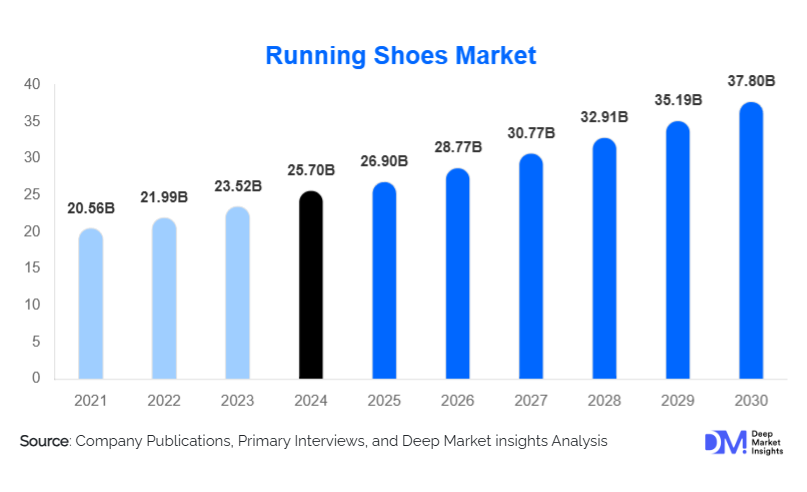Global Running Shoes Market Poised to Reach USD 37.8 Billion by 2030 Driven by Marathon Participation, Health Awareness, and Technological Innovation

According to Deep Market Insights, " The global running shoes market, valued at USD 25.7 billion in 2024, is projected to grow steadily to USD 37.8 billion by 2030, registering a compound annual growth rate (CAGR) of 6.95% from 2025 to 2030." Growth is fueled by rising marathon participation, the spread of recreational running, and increasing consumer focus on health and wellness.
A recent survey of 1,000 runners conducted by Deep Market Insights underscores shifting consumer preferences. About 62% of respondents identified cushioning and comfort as the most important factors in purchasing decisions, while 40% expressed willingness to pay a premium for shoes made with sustainable materials. These findings highlight two key growth drivers: performance-focused design and eco-friendly innovation.
Market Size and Growth
-
2024 Market Size: USD 25.7 billion
-
2030 Market Size: USD 37.8 billion
-
CAGR (2025–2030): 6.95%
North America held the largest share of the market in 2024, while Europe is projected to record the fastest growth over the forecast period.
Key Market Insights
-
Neutral running shoes remain the largest product category, appealing to everyday runners through versatile cushioning.
-
Carbon plate running shoes are fueling growth in the premium segment, particularly among marathon participants and elite athletes.
-
Trail running shoes are showing strong momentum in North America and Europe, reflecting increasing outdoor recreation.
-
The U.S. continues to be the single largest demand hub, while China and Asia-Pacific are experiencing the fastest growth trajectory.
Emerging Trends
-
Elite performance adoption: Carbon-fiber plate technology, popularized by models such as Nike Alphafly and Adidas Adizero Adios Pro, is now being embraced by advanced amateur runners.
-
Trail specialization: Rising participation in mountain and ultra-distance events in France, Spain, and the U.S. is driving demand for specialized trail designs with improved grip, stability, and weather resistance.
-
Sustainability focus: Brands including Allbirds, Hoka, and Veja are investing in sustainable materials such as sugarcane-based EVA and recycled polyester.
-
Digital engagement: Virtual try-ons, customization tools, and direct-to-consumer channels are reshaping consumer purchasing behavior and brand interactions.
Market Drivers
-
Marathon participation: Expanding marathon culture across established hubs like Tokyo, Berlin, and Boston, as well as emerging events in India, China, and Australia, is creating steady demand for performance footwear.
-
Recreational fitness trends: Rising urban health awareness and fitness-driven lifestyles are driving sales of neutral and stability shoes designed for comfort and injury prevention.
-
Technological innovation: Advancements in cushioning, lightweight foams, carbon plates, and biomechanical engineering are sustaining consumer demand and accelerating replacement cycles.
Market Restraints
-
High retail prices of advanced models, often above USD 250, limit accessibility in price-sensitive markets.
-
Counterfeiting and grey market challenges undermine brand credibility, particularly in Asia and Latin America.
-
Sustainability and material constraints hinder mass adoption of eco-friendly models due to high costs and limited supply chains.
Market Opportunities
-
Expansion in emerging markets: Growing disposable incomes and sports participation in Asia-Pacific and Latin America offer strong growth opportunities.
-
Women’s running segment: Rising female participation in running events opens demand for gender-specific designs and fit-focused offerings.
-
Direct-to-consumer growth: Proprietary online channels allow brands to capture margins, build loyalty, and deliver personalized experiences.
-
Strategic collaborations: Sponsorships of global races such as the Boston Marathon and UTMB, along with athlete endorsements, continue to drive visibility and influence purchase behavior.
Regional Insights
-
North America: Largest market, supported by marathon culture, recreational running, and high consumer spending power.
-
Europe: Strong demand for trail and performance shoes, with sustainability shaping purchasing decisions.
-
Asia-Pacific: Fastest-growing region, led by China and Japan, with growth driven by marathons, government fitness initiatives, and expanding middle-class populations.
-
Latin America: Brazil and Mexico are leading demand growth, supported by urbanization and rising sports participation.
-
Middle East and Africa: Urban centers such as Dubai, Riyadh, and Johannesburg are driving demand, aided by rising disposable incomes and growing retail networks.
Competitive Landscape
Nike leads the market with a 27% share, bolstered by its Alphafly and ZoomX product lines. Adidas follows with 19%, supported by the Adizero and Ultraboost series. Other significant players include ASICS, New Balance, Hoka, Puma, Brooks, Saucony, Mizuno, Under Armour, Salomon, Skechers, Li-Ning, and Anta Sports. Together, these companies continue to expand global presence through product innovation and event-driven marketing.
Recent Developments
-
March 2025: Nike launched Alphafly 4 featuring next-generation ZoomX cushioning and an enhanced carbon plate.
-
May 2025: Adidas introduced Adizero Prime X Strung in China with advanced textile engineering for fit and responsiveness.
-
July 2025: Hoka expanded its Clifton series with sugarcane-based EVA midsoles, reinforcing its sustainability agenda.
- Art
- Causes
- Crafts
- Dance
- Drinks
- Film
- Fitness
- Food
- الألعاب
- Gardening
- Health
- الرئيسية
- Literature
- Music
- Networking
- أخرى
- Party
- Religion
- Shopping
- Sports
- Theater
- Wellness




